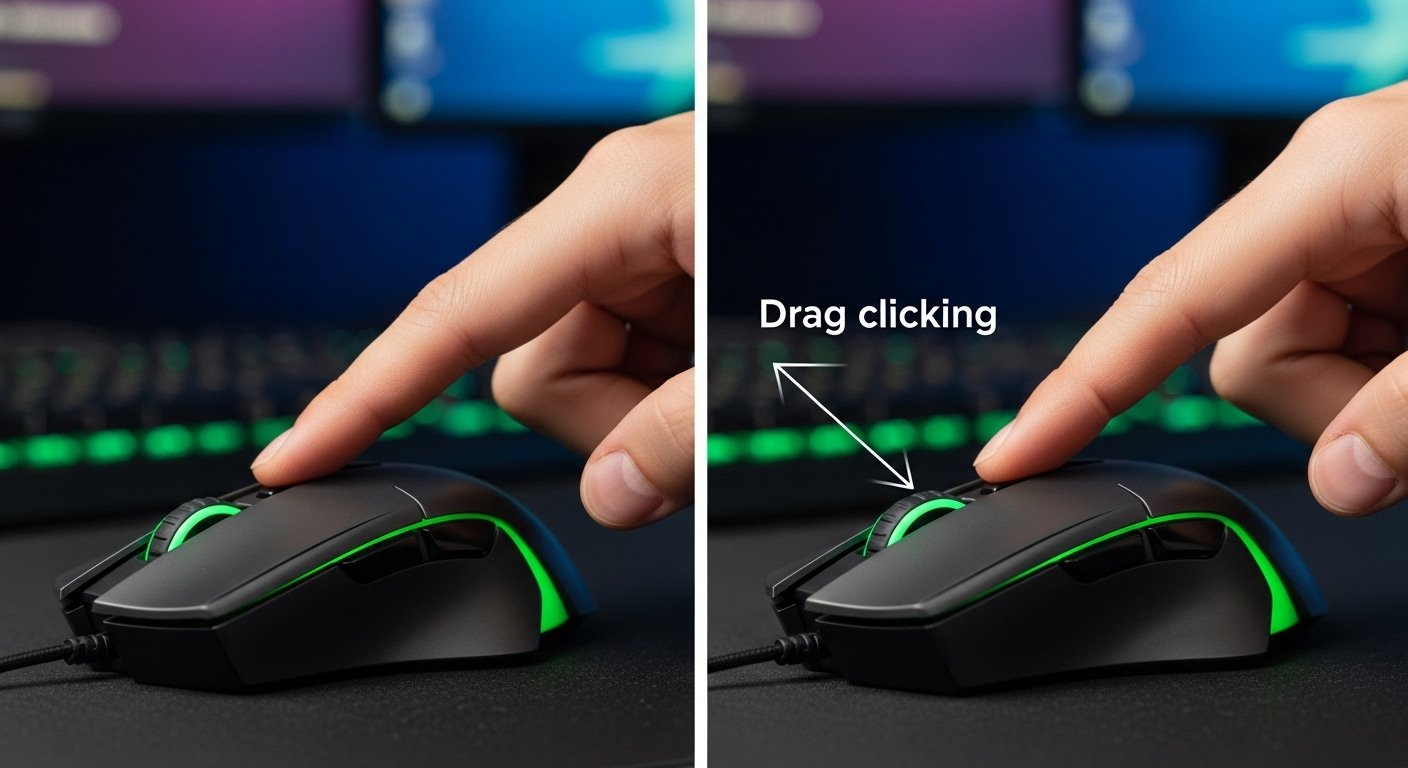You’ve been there. It’s the final moments of a frantic battle, your entire focus narrowed to a single point on the screen. Your heart is pounding, your palm is sweating, and your finger is a blur, clicking with a desperate speed you didn’t know you possessed. In that moment, the raw speed of your finger feels like the only thing that matters. This fundamental skill, the ability to actuate your mouse button as fast as humanly possible, is measured by a core metric in the gaming world. So, what is CPS (Clicks Per Second)? It is the universal language of gaming speed, a simple number that defines how quickly you can interact with your digital world. This guide is your ultimate resource to demystify this critical performance indicator, transforming it from just a score into a tangible skill that any gamer can understand, measure, and, most importantly, improve.
This is not just a basic dictionary definition. This is a complete tour of the world of click speed, designed for gamers of all skill levels. We will break down the simple formula behind this key metric and explore how it became a legendary benchmark in competitive gaming. You will learn the “Big Three” high-speed clicking techniques—Jitter, Butterfly, and Drag clicking—with a clear breakdown of the pros and cons of each. We will provide a comprehensive guide to what a “good” score looks like and explore how this concept applies beyond Minecraft to the FPS and MOBA genres. But before you can improve, you must know where you stand. The first step on your journey is to get your baseline score on a CPS test. This number is your starting line. By the end of this guide, you’ll have a full training plan to leave it far behind in the dust.
Of course. Here is the next section, with all required links included.
The Simple Definition: What Does CPS Actually Measure?
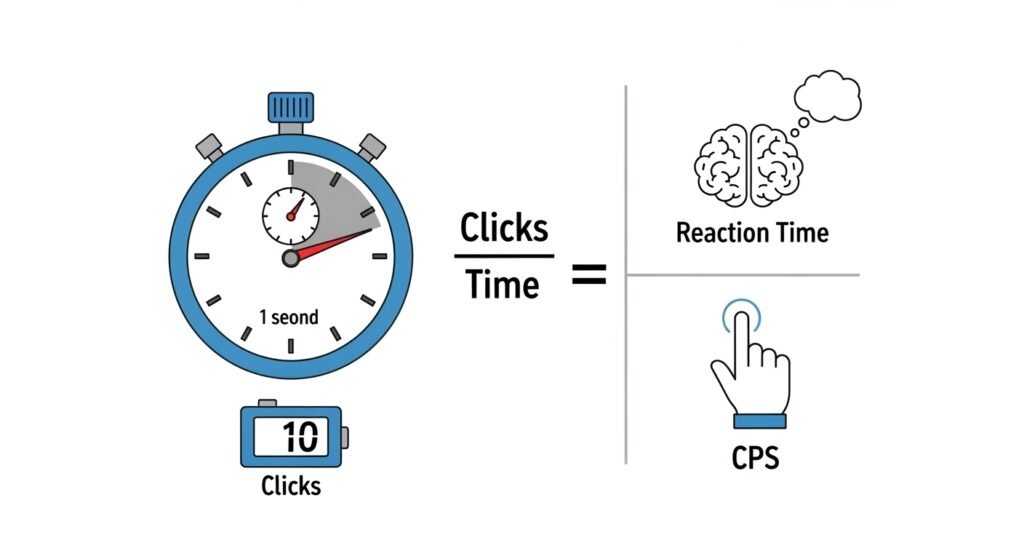
At its core, Clicks Per Second (CPS) is a direct measurement of your clicking speed. It’s a simple rate that calculates how many times you can press your mouse button within a one-second timeframe. It is the fundamental benchmark for manual input speed and serves as a clear, objective score to gauge your raw mechanical performance. It’s not a vague feeling of being “fast”—it’s a hard number that proves it.
The Basic Formula: Clicks Divided by Time
The math behind your CPS score is incredibly simple. Every online test uses the same basic formula:
CPS = Total Number of Clicks / Total Time in Seconds
For example, if you take a 10-second test and click the mouse button 80 times, you would divide 80 by 10 to get a score of 8 CPS. It’s a pure measure of frequency. You don’t need to do the math yourself; any online tool, even a basic click counter, will calculate your rate automatically, giving you instant feedback on your performance.
The Critical Difference: Why CPS is Not the Same as Reaction Time
This is one of the most common and important misconceptions among gamers. While related, CPS and reaction time are two completely different skills.
- Reaction Time is your brain’s speed. It’s how quickly you can perceive a stimulus (like an enemy appearing on screen) and send the signal to your hand to act.
- CPS is your hand’s speed. It’s how quickly your finger can physically execute the “click” command once that signal has been received.
Think of it like a sprinter. Reaction time is the delay between the starting pistol firing and the runner’s muscles first twitching. CPS is how fast their legs can move once they are actually running. You can have lightning-fast reactions, but if your finger is physically slow to press the button, you create a bottleneck that delays your in-game action. As explained by neuroscience resources from institutions like the National Institutes of Health (NIH), reaction time is a complex cognitive process, while clicking speed is a measure of fine motor performance.
A Personal Story: The First Time I Tested My CPS (and Why I Was So Wrong About It)
For years, I just assumed I was a “fast” gamer. I played competitive shooters at a decent level, and I felt quick. I figured my click speed must be high. Then, one day, a friend challenged me to an actual test. I was confident I’d post a huge score. I loaded up a simple CPS test for 5 seconds, took a deep breath, and let it rip.
The result? 6.2 CPS. I was shocked. It wasn’t bad, but it was thoroughly average. My friend, who I always considered a more strategic but slower player, hit a 7.8. It was a humbling moment. I realized that my success in games came from my aim and strategy, not from raw clicking speed. But it was also incredibly motivating. It revealed a clear, measurable weakness in my mechanical skills that I had never known existed. It wasn’t a judgment of my ability as a gamer; it was simply a new stat I could start training to improve.
How CPS Became a Legendary Metric in the Gaming World
Clicks Per Second didn’t become a famous metric by accident. It rose to prominence on the digital battlefields of one of the most popular games in history. Its journey from a niche technical term to a core part of the gamer lexicon is a story about how game mechanics can shape player culture, creating new ways for people to compete and measure their skill.
The “Minecraft Effect”: How PvP Battles Made Click Speed Famous
The explosion of CPS as a competitive stat can be traced directly back to Minecraft PvP. Unlike many modern games with ability cooldowns and complex combat systems, early Minecraft combat was brutally simple. A player’s ability to deal damage was directly tied to how quickly they could click their mouse. This created a unique environment where a higher click speed provided a direct, tangible advantage. Landing more hits than your opponent meant you could “combo” them, interrupting their movement and securing a decisive victory. This mechanic is why what is CPS (Clicks PerSecond)? became a critical question for millions of players looking to gain an edge.
The Cultural Impact of Tools like the Kohi Click Test
As the Minecraft PvP scene grew, so did the need for a standardized way to measure this crucial skill. This led to the creation of specialized testing tools, with one rising above all others in legendary status: the Kohi Click Test. Kohi was a famous competitive Minecraft server, and its click test became the unofficial gold standard for the community. Achieving a high score on the Kohi Click Test was more than just a number; it was a badge of honor, a status symbol that proved you were a serious contender. This tool and others like it created a global leaderboard culture, allowing players from all over the world to benchmark their skills against the very best.
Benchmarking Your Skill: Using CPS as a Personal Yardstick
Beyond the competitive scene, the CPS test found a second life as a personal development tool. Gamers are, by nature, driven by metrics and improvement. Just as we love to see our character level up in an RPG, we love to see our own real-world skills improve. The CPS test provides a simple, instant way to quantify a physical skill. It’s a personal high score that you can work to beat. This desire to measure all aspects of our performance is common in gaming, extending to other inputs like those measured by a keyboard CPS test. The act of testing, practicing, and seeing your score slowly climb is an engaging and rewarding process, which is a core principle of skill acquisition explained by performance psychologists and covered in many mainstream articles on esports training by outlets like Wired.
The “Big Three” High-CPS Techniques Deconstructed
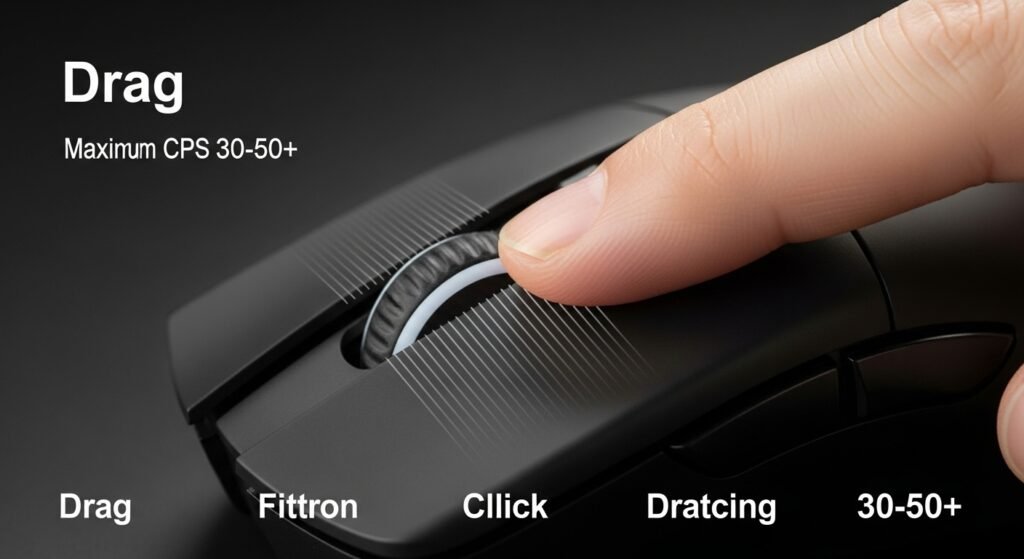
Achieving an elite Clicks Per Second score is rarely accomplished with a normal clicking style. It requires a specialized physical technique. Over the years, the competitive gaming community has developed and perfected three distinct methods to push the limits of human speed. Each of these “Big Three” techniques is a skill in itself, with a unique mechanism, a steep learning curve, and its own set of advantages and disadvantages. Understanding them is a core part of answering the question, what is CPS (Clicks Per Second)?, because they represent the peak of what is physically possible.
Jitter Clicking: The Controlled Vibration Method
Jitter clicking is a technique where you tense the muscles in your arm and wrist to create a high-speed vibration. This controlled shaking is channeled through your finger and onto the mouse button, creating a rapid-fire stream of clicks.
- How it works: Instead of consciously pressing the button for each click, you create one continuous muscle spasm. It’s less about individual clicks and more about letting a high-frequency tremor do the work for you. It’s a skill that requires significant practice to isolate the vibration without sacrificing all of your aim. Many players start their training with a jitter click test for 10 seconds to build stamina.
Butterfly Clicking: The Two-Finger Drumming Technique
Butterfly clicking involves using two fingers—usually the index and middle finger—to rapidly and alternately tap on a single mouse button. This creates a drumming motion that can produce an incredibly high and consistent click rate.
- How it works: By alternating fingers, you effectively double your clicking potential, as one finger can be in motion while the other is resetting. This technique is also known for taking advantage of a hardware flaw called “double-clicking,” where a single press registers two inputs. A mouse’s susceptibility to this can be measured with an ultimate double-click test.
Drag Clicking: The Friction-Based Speed Anomaly
This is the most extreme and specialized technique. Drag clicking involves dragging your finger across the mouse button with just the right amount of pressure to create friction. This friction causes the skin on your finger to rapidly stick and slip, vibrating the switch underneath and registering an insane number of clicks.
- How it works: This method is more of a controlled physics exploit than a traditional clicking style. It requires a mouse with a specific matte texture and is almost useless for aiming. However, for sheer CPS, it is unmatched, capable of producing scores of 100+ CPS when measured on a dedicated drag click test.
Comparison Table: Speed vs. Aim vs. Strain for Each Method
| Technique | Max Potential CPS | Aim Difficulty | Physical Strain |
| Jitter Clicking | 12 – 18 CPS | High | High (Arm/Wrist) |
| Butterfly Clicking | 15 – 25+ CPS | Very High | Moderate (Fingers) |
| Drag Clicking | 30 – 100+ CPS | Nearly Impossible | Low (but high mouse wear) |
What is a “Good” CPS Score? (A Gamer’s Benchmarking Guide)
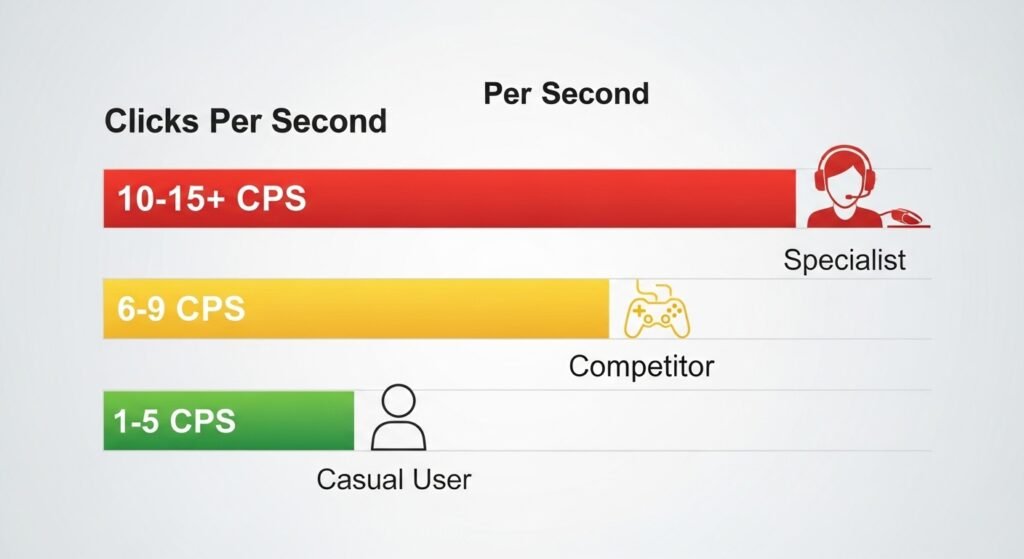
The “magic number” for a good Clicks Per Second score is not a single value; it’s a spectrum that depends entirely on your goals, your game, and your playstyle. A graphic designer’s “good” score is completely different from that of a top-tier Minecraft player. Understanding these benchmarks is key to setting realistic goals for yourself and knowing where you stand in the grand hierarchy of clicking speed.
The Baseline (1-5 CPS): The Average Computer User
This is the range where the vast majority of non-gamers fall. This speed is perfectly adequate for everyday computer tasks like browsing the web, working on documents, and navigating your operating system. There’s absolutely nothing wrong with being in this range—it simply means that high-speed clicking isn’t a skill you’ve needed to develop. Think of this as a normal walking pace; it gets you where you need to go reliably and without any strain.
The Competitor (6-9 CPS): The Serious Gamer
This is the sweet spot for most dedicated gamers who use a standard clicking technique. A score between 6 and 9 CPS is a clear sign of a fast and responsive finger. It’s quick enough to be highly effective in almost any gaming genre, from fast-paced FPS titles to high-action MOBAs. If you are a serious player looking to improve your mechanical skills, achieving a consistent score in this range is a fantastic goal. This is the level where you can confidently benchmark your speed and know you are faster than the average player.
The Specialist (10-15+ CPS): The High-Skill Elite
Welcome to the top tier. A score of 10 CPS or higher is nearly impossible to achieve with a normal clicking style. This is the domain of specialists who have dedicated significant time to mastering advanced techniques like Jitter or Butterfly clicking. This level of speed is most famous and most effective in games like Minecraft, where it can provide a significant combat advantage. However, this blistering speed often comes at the cost of accuracy, making it less practical in precision-based shooters.
Why Your “Effective CPS” (Speed + Accuracy) is What Truly Matters
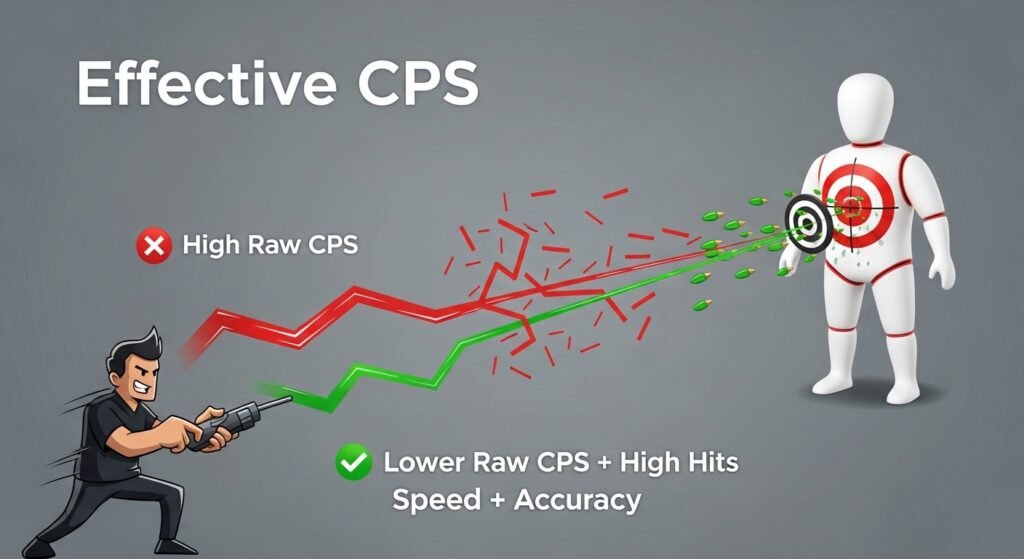
This is the most important takeaway in this entire guide. A high score on a CPS test is a fun metric, but in a real game, it is utterly meaningless without accuracy. Your Effective CPS (eCPS) is the number of meaningful clicks you land on a target.
A player who has 14 CPS but only hits their target 50% of the time has an eCPS of 7. A player with a “lower” score of 8 CPS who has perfect aim has an eCPS of 8. The second player is more effective and will win the fight. Speed is nothing without control. That’s why your training should always include not just speed tests, but also aim trainers and ensuring your mouse DPI settings are optimized for precision. Never sacrifice accuracy for the sake of a higher number on a testing tool.
Beyond Minecraft: Where CPS Matters in Other Major Genres
While the question “what is CPS (Clicks Per Second)?” was born in the world of blocky PvP, the skills it measures are universally applicable across the entire landscape of competitive gaming. A fast, controlled, and consistent clicking finger is a core component of mechanical skill, whether you’re landing headshots in an FPS, kiting enemies in a MOBA, or managing your army in an RTS. The context changes, but the need for speed remains.
In FPS Games (Valorant, CoD): The Importance of “First-Click Latency” for Peeking and ADS
In tactical shooters, your overall click-spamming ability is far less important than your “first-click latency”—the speed of your very first, decisive press. When you peek a corner and an enemy is there, the duel is often decided by who can Aim Down Sights (ADS) and fire accurately first. This is a two-click sequence (right-click to aim, left-click to shoot). A slow finger on either of these clicks creates a fatal delay. Your practice here isn’t about achieving a high score on a 10-second test; it’s about minimizing the time of that single, critical press, a skill you can train by focusing on your mouse right-click test speed.
In MOBAs & RPGs (League of Legends, WoW): How CPS Relates to APM, Kiting, and Animation Canceling
In MOBAs and many RPGs, click speed is a key component of a broader metric: APM (Actions Per Minute). Elite players perform hundreds of actions every minute, and a huge number of those are mouse clicks for movement and attacking. High-skill techniques like “kiting” (attacking while moving away from an opponent) require a rapid and rhythmic alternation between right-clicks (to move) and left-clicks (to attack). A higher consistent CPS allows a player to perform these actions more quickly, creating more space and dealing more damage. The rhythm and stamina required are similar to the skills honed by the legendary Kohi Click Test.
Case Study: How I Improved My Farming in a MOBA by Focusing on Click Consistency
I used to struggle with “last-hitting” minions in League of Legends. I knew I needed to land the final blow to get the gold, but my timing always felt slightly off, and I would miss a significant amount of farm, putting me behind. I realized the problem wasn’t just my timing; it was the physical consistency of my clicks. I started using a simple online click counter for a few minutes before playing. My goal wasn’t to set a speed record, but to practice a consistent, deliberate clicking rhythm. This simple drill trained my finger to act precisely when my brain wanted it to. Within a week, my last-hitting improved dramatically. I was more in sync with the game, and my gold income skyrocketed, all because I focused on improving the basic consistency of my CPS.
The Dark Side of High CPS: A Serious Talk About Health and Hardware
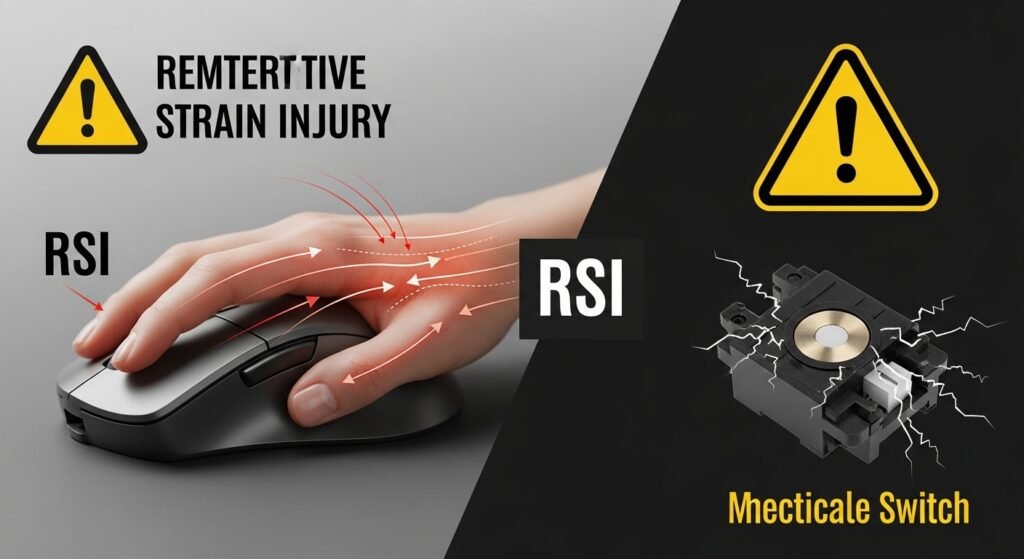
The quest for a god-tier Clicks Per Second score is exciting, but it’s a pursuit that is not without its risks. Pushing your body and your equipment to their absolute limits can have real, lasting consequences. Before you dedicate hours to mastering high-speed techniques, it is your responsibility as a player to understand the potential downsides. A smart gamer is a healthy gamer, and a healthy gamer can play for years to come.
Protecting Your Most Important Gear (Your Hands): Ergonomics and Preventing RSI
Your gaming mouse is replaceable; your hands are not. The rapid, repetitive motions required for techniques like jitter and butterfly clicking can put significant strain on the delicate muscles, tendons, and nerves in your fingers, wrist, and arm. This can lead to painful conditions like Repetitive Strain Injury (RSI) or Carpal Tunnel Syndrome.
Your Prevention Plan:
- Maintain Proper Posture: Sit with your back straight and your feet flat on the floor. Your elbow should be at a roughly 90-degree angle, and your wrist should be in a straight, neutral position, not bent up or down.
- Take Regular Breaks: For every hour of gaming, take at least a five-minute break to stand up and stretch.
- Perform Stretches: Gently perform wrist circles and finger stretches before and after long gaming sessions. As authoritative health sources like the Mayo Clinic explain in detail, preventing these conditions is far easier than treating them. The same risks apply to other repetitive challenges, like those measured on a space bar click test.
How Chasing a High Score Can Literally Destroy Your Gaming Mouse
Your mouse’s buttons are not invincible. Inside each button is a mechanical switch with a rated lifespan, often measured in millions of clicks (e.g., 50 million). High-CPS techniques burn through this lifespan at an incredible rate. A single hour of intense butterfly clicking can subject your mouse to more clicks than a week of normal use.
This accelerated wear and tear can lead to two main problems:
- Switch Failure: The button may become unresponsive or stop working altogether.
- Unintentional Double-Clicking: The most common failure is the switch wearing down and starting to register two clicks from a single press. This can make your mouse incredibly frustrating to use for normal tasks. You can check the health of your switches with an ultimate double-click test to see if they are starting to fail.
Are High-CPS Techniques Considered Cheating? Server Rules Explained
This is a gray area that every competitive player needs to understand. The short answer is: No, the techniques themselves are not considered cheating because they do not use any third-party software or macros. They are a physical skill.
However, the result of these techniques can sometimes get you into trouble. Many popular game servers (like Hypixel for Minecraft) use automated anti-cheat systems that look for “inhuman” click rates. A player using a good butterfly or drag clicking technique, which can be measured with a drag click test, might achieve a CPS so high that the server’s software mistakes them for an auto-clicker. This can lead to a temporary, or in some cases, a permanent ban. It’s always crucial to be aware of the specific rules of the server you are playing on.
Your Simple Training Plan to Improve Your CPS Score
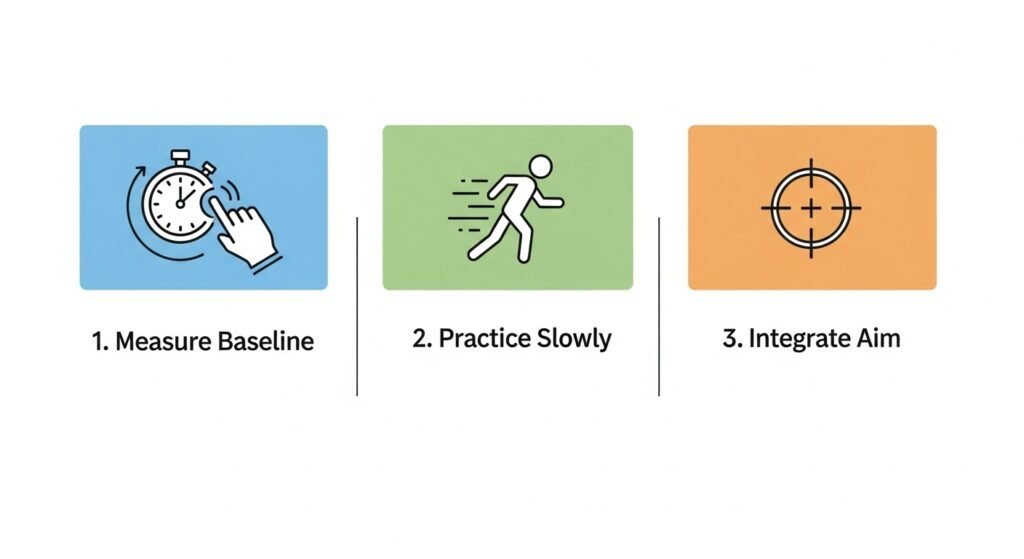
Knowing about high-speed clicking techniques and actually executing them are two different worlds. Improvement requires a smart, structured approach. Mindlessly spamming a click test will only lead to fatigue and bad habits. This simple, three-step training plan is designed to build your skill the right way, focusing on creating a solid foundation of muscle memory and then translating that raw speed into real, usable in-game performance.
Step 1: Measure Your True Baseline with a CPS Test
Before you start your training, you need an honest starting number. This isn’t about getting a warm-up or trying to get a lucky score; it’s about establishing a true baseline that you can track your progress against.
- Go to a standard CPS test.
- Choose the 10-second option, which is a great balance of speed and consistency.
- Without any warm-up, take the test one time.
- Write down your CPS score. This is your personal record, the number you are now officially on a mission to beat.
Step 2: Choose ONE Technique and Practice it Slowly
The biggest mistake beginners make is trying to learn Jitter and Butterfly clicking at the same time. You will master neither. Choose ONE of the “Big Three” techniques that feels the most comfortable or interesting to you.
Once you’ve chosen your style, your initial goal is not speed, but consistency. Spend 5-10 minutes each day practicing the motion slowly. If you chose Jitter clicking, focus on creating a steady, even vibration. If you chose Butterfly, focus on a perfect 1-2-1-2 rhythm. Use a practice tool like a jitter click test not to set a record, but to watch the graph and ensure your clicks are evenly spaced. You are building the correct muscle memory. Speed is a byproduct of a flawless, consistent technique.
Step 3: Integrate Your Speed with Aim Trainers for Real-World Skill
A high CPS score is a vanity metric if you can’t hit your target. Once you start to feel comfortable with the motion of your chosen technique, you must immediately integrate it with aiming practice. This is the step that turns raw speed into effective, game-winning skill.
Use a dedicated aim trainer—popular and highly effective options include Aim Lab on Steam or KovaaK’s. Start with simple “Tile Frenzy” or “Gridshot” scenarios. Your goal is to practice clicking on the static targets while using your new high-speed technique. It will feel incredibly awkward at first, and your accuracy will be terrible. That’s okay. This is where you bridge the gap between the testing tool and the game, teaching your hand to maintain speed while making precise movements. This is the step that builds true mechanical skill.
Frequently Asked Questions (FAQ)
You’ve learned the definition, the techniques, the risks, and the training plan. But a few specific, technical questions often come up. Here are the direct answers to the most common queries about the world of Clicks Per Second.
How is CPS officially calculated?
Does my mouse’s DPI or polling rate affect my CPS?
DPI (Dots Per Inch) is your mouse’s sensitivity. It doesn’t change how fast you can physically click, but an incorrect DPI will ruin your aim. You can find and calibrate your ideal settings with a mouse DPI test.
Polling Rate is how often your mouse reports its position to your computer. A higher polling rate (like 1000Hz) reduces input lag, ensuring your clicks are registered as quickly as possible. You can check this with a polling rate checker.
What is the official world record for human CPS?
Can I improve my CPS on a laptop trackpad?
Conclusion
You’ve reached the end of our complete guide, and the answer to the question, “what is CPS (Clicks Per Second)?”, should now be crystal clear. It is far more than just a number from a Minecraft duel; it’s a fundamental measure of your mechanical skill, a tangible benchmark you can train, and a critical component of high-level play across all of gaming. You now have the knowledge to not only measure your own speed but to understand the techniques, the risks, and the training required to push your performance to new heights.
Remember that frantic battle from the beginning, where the speed of your finger felt like a desperate, last-ditch effort? Armed with this guide, that desperation can be replaced with confidence. The frantic clicking can become a controlled, precise, and deadly weapon in your arsenal. Your journey to a higher click speed doesn’t require a giant leap; it begins with a single, simple action. We challenge you to take a 10-second CPS test right now and officially start your journey of improvement.
Which clicking technique are you most excited to try first?

Hello, I’m John Harbour, a software developer passionate about creating innovative and accessible AI tools. As the creator of cps-checker.com, I enjoy building useful software and writing blogs to help people get the most out of my creations.

